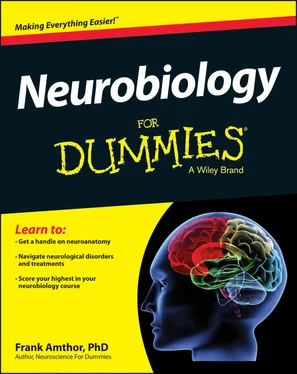9 Part V: The Part of Tens Chapter 19: The Ten Most Important Brain Circuits The Reticular Formation in the Brainstem The Spinal Reflex The Thalamic Relay to the Cortex Cerebellar Modulation of Motion Sequences Hippocampal Reciprocal Activation with the Cortex The Amygdala Orbitofrontal Cortex Loop The Spinal Pattern Generator The Conscious Triangle: Frontal and Sensory Cortex with the Thalamus The Basal Ganglia Thalamus Loop The Anterior Cingulate and Pulvinar Central Executives Chapter 20: Ten Technologies Revolutionizing Brain Science Optogenetics: Controlling Neurons with Light Transcranial Magnetic Stimulation and Transcranial Direct Current Stimulation Genetic Disease Models: Knockouts and Knockins Brain Imaging: Optical, Magnetic, and Electrical Interfacing Brains with Computers Deep Brain Stimulation Multi-Electrode Array Recording Fluorescence and Confocal Microscopy Advances in Electrophysiological Recording Tissue Culture and Brain Slices
10 Index
11 About the Author
12 Connect with Dummies
13 End User License Agreement
1 Chapter 2 Figure 2-1: Phospho-lipid molecular structure. Figure 2-2: A simplified ball-and-stick model of a single phospholipid molec... Figure 2-3: Phospho-lipid molecules assemble to form the plasma membrane. Figure 2-4: Two neurons from a rabbit retina: a starburst amacrine cell (left), and a...
2 Chapter 3 Figure 3-1: The sodium-potassium pump creates a disequilibrium between sodium and ... Figure 3-2: Event sequence underlying action potential, including voltage across the ... Figure 3-3: Electrical model of the distributed membrane resistance and capacitance... Figure 3-4: Types of glia cells (microglia, astrocytes, and myelin-producing Schwa...
3 Chapter 4 Figure 4-1: Structure, molecules, and sequence for neuro-transmitter release. Figure 4-2: Gap junction synapses.
4 Chapter 5Figure 5-1: An antagonistic flexor-extensor muscle pair.Figure 5-2: Myosin-action movement in a sarcomere.Figure 5-3: The alpha motor neuron axon terminal at the end plate.Figure 5-4: A spinal reflex neural circuit.
5 Chapter 6Figure 6-1: The spinal cord in relation to the vertebrae of the back.Figure 6-2: Spinal cord segments and some of their functions.Figure 6-2: Spinal cord segments and some of their functions.Figure 6-3: Gray and white matter inside the spinal cord.Figure 6-4: Spinal cord tracts.Figure 6-5: The cerebellum.Figure 6-6: Divisions of the cerebellum.Figure 6-7: The autonomic nervous system.
6 Chapter 7Figure 7-1: The brainstem: medulla, pons, and midbrain.Figure 7-2: Medulla cross section.Figure 7-3: Midbrain superior and inferior colliculi.Figure 7-4: Neocortex, mesocortex, and allocortex.Figure 7-5: The limbic system.Figure 7-6: The hippocampus.Figure 7-7: A hypnogram.Figure 7-8: EEG sleep patterns during different stages of sleep.
7 Chapter 8Figure 8-1: Coronal brain section showing basal ganglia.Figure 8-2: Organization of the basal ganglia.Figure 8-3: SMA (internal) and PMC (external) motor control circuits.
8 Chapter 9Figure 9-1: Lobes of the neocortex.Figure 9-2: Three ways to section brain.Figure 9-3: Neocortex gray matter and layers.Figure 9-4: Thalamic–cortical connections.Figure 9-5: Neocortex: controller or subroutine?Figure 9-6: The evolution of the prefrontal cortex.Figure 9-7: Brodmann areas of the neocortex.
9 Chapter 10Figure 10-1: Focusing light by the eye.Figure 10-2: Distribution of rods and cones in the retina.Figure 10-3: The neural circuit in the retina.Figure 10-4: Cone spectral sensitivity curves.Figure 10-5: Retinal projections to the thalamus and visual cortex.Figure 10-6: The anatomy of the auditory system.
10 Chapter 11Figure 11-1: Mechano-receptors in the skin.Figure 11-2: The somatosensory cortex.Figure 11-3: Olfactory receptors and the olfactory bulb.Figure 11-4: Projections of the olfactory bulb.Figure 11-5: Taste receptors on the tongue.Figure 11-6: Central projections for taste.
11 Chapter 12Figure 12-1: A memory taxonomy.Figure 12-2: Cortical inputs to the hippocampus.
12 Chapter 13Figure 13-1: The organization and connections of major cell types of the cerebellum.
13 Chapter 14Figure 14-1: Correlated firing.Figure 14-2: Language areas of the brain.
14 Chapter 15Figure 15-1: Meiosis.Figure 15-2: Structures of the developing nervous system.Figure 15-3: Radial glia and neural migration form neocortex minicolumns.
1 Cover
2 Title Page
3 Copyright Page
4 Table of Contents
5 Begin Reading
6 Index
7 About the Author
1 i
2 ii
3 1
4 2
5 3
6 4
7 5
8 6
9 7
10 8
11 9
12 10
13 11
14 12
15 13
16 14
17 15
18 16
19 17
20 18
21 19
22 20
23 21
24 22
25 23
26 24
27 25
28 26
29 27
30 28
31 29
32 30
33 31
34 32
35 33
36 34
37 35
38 36
39 37
40 38
41 39
42 40
43 41
44 42
45 43
46 44
47 45
48 46
49 47
50 48
51 49
52 50
53 51
54 52
55 53
56 54
57 55
58 56
59 57
60 58
61 59
62 60
63 61
64 62
65 63
66 64
67 65
68 66
69 67
70 68
71 69
72 70
73 71
74 72
75 73
76 74
77 75
78 76
79 77
80 78
81 79
82 80
83 81
84 82
85 83
86 84
87 85
88 86
89 87
90 88
91 89
92 90
93 91
94 92
95 93
96 94
97 95
98 96
99 97
100 98
101 99
102 100
103 101
104 102
105 103
106 104
107 105
108 106
109 107
110 108
111 109
112 110
113 111
114 112
115 113
116 114
117 115
118 116
119 117
120 118
121 119
122 120
123 121
124 122
125 123
126 124
127 125
128 126
129 127
130 128
131 129
132 130
133 131
134 132
135 133
136 134
137 135
138 136
139 137
140 138
141 139
142 140
143 141
144 142
145 143
146 144
147 145
148 146
149 147
150 148
151 149
152 150
153 151
154 152
155 153
156 154
157 155
158 156
159 157
160 158
161 159
162 160
163 161
164 162
165 163
166 164
167 165
168 166
169 167
170 168
171 169
172 170
173 171
174 172
175 173
176 174
177 175
178 176
179 177
180 178
181 179
182 180
183 181
184 182
185 183
186 184
187 185
188 186
189 187
190 188
191 189
192 190
193 191
194 192
195 193
196 194
197 195
198 196
199 197
200 198
201 199
202 200
203 201
204 202
205 203
206 204
207 205
208 206
209 207
210 208
211 209
212 210
213 211
214 212
215 213
216 214
217 215
218 216
219 217
220 218
221 219
222 220
223 221
224 222
225 223
226 224
227 225
228 226
229 227
230 228
231 229
232 230
233 231
234 232
235 233
236 234
237 235
238 236
239 237
240 238
241 239
242 240
243 241
244 242
245 243
246 244
247 245
248 246
249 247
250 248
251 249
Читать дальше












